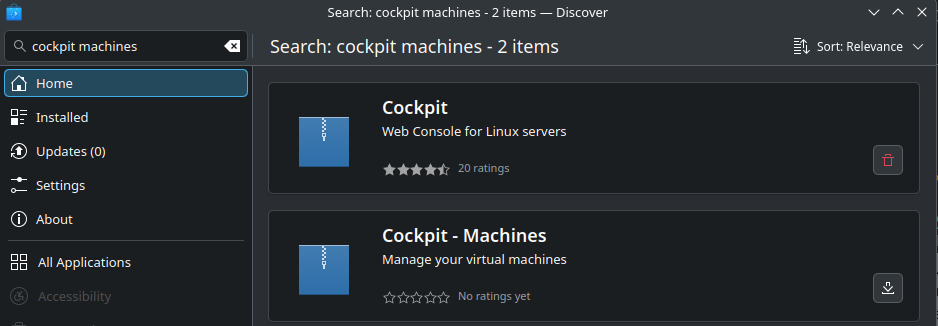Not really sure how dualbooting or vms work at their core. I’m kind of over windows and want to swap, always liked the customizability aspect and have been using Linux more and more for self hosting purposes. Was wondering if I setup linux on my external ssd using a vm if I could change it from vm to a dualboot drive after I’m done setting it up. That way I could setitup and swap to it while keepign my original ssd with my windows install,. and not have to deal with dualbooting and going back and forth while setting up?
Can I make a vm of my current windows machine backup and run that in a linux setup?
long ago redhat had a way of outputing a kickstart file to use to instal on other machines and suse had something similar. no idea what they use for that now though.
If you go with NixOS or guix, both of which are declaratively configured, you can swap 99.9% seamlessly. I run the same NixOS config on 2 machine and a VM. Only thing I had to modify between them are some driver specific settings, but those are easy to isolate.
NixOS and Guix are both very beginner-unfriendly. If you’re not very comfortable with Linux and its command line, I’d recommend against using them for personal systems.
You can, but it’s a bit difficult.
My suggestion would be to use a LiveCD. Test it out and see if like whichever distro you choose. It completely replicates the feeling of *nix being on your hardware without any commitment.
no dual boot. just jump in, the water is fine.
Piracy seems harder, like whats the alternative to vfxmed for stuff like houdinifx
I can’t help with pirating software, your options are going to be heavily limited because most people running Linux would just prefer open source alternatives (like Blender), so it’s far less likely you will find cracked software specifically made for Linux (plus, there is a far smaller userbase). On some quick searching, I did find someone who had issues running Houdini in a VM (for multiple distros), but it worked fine when it was installed natively. I’m not seeing an entry in the WINE database for Houdini, so while you could always try running a Windows version through WINE, given the type of program it is, I highly doubt it would run without issue. I have no recommendations on how to get ahold of a Linux compatible version without a license.
I have to imagine there are more than a few substitutes on Linux, it’s not dealing with all the Windows DRM bullshit. And it’s where all the nerds hang out, and nerds like their piracy.
Arrr.
What is that
Used to play videogames now I spend days making reusable vfx that I never end up using, need to buy some interesting mocaps because I dont like hand animating ive come to find
Hollywood vfx, 3d procedural modeling software (also used for setting up game environments and a ton of other stuff), I enjoy using it, might someday buy it, but its only a hobby I make no money off so I pirate it
Yeah I’d definitely dual booting while you wet your toes if you want to go full linux, then run a windows vm of you cant find anyway to replace that.
I run a windows vm on my server for my 360 tour and editing stuff but everything else is on my main linux machine now
Houdini FX has a Linux version, you’d just have to find a copy of it for Linux.
Correct, but I believe the user is looking for a cracked version, as they don’t have a license. The likelihood of that existing is significantly lower on Linux than it is for Windows given the much smaller userbase, the fragmentation into multiple package formats, and the overall distaste of proprietary software in the Linux community.
My recommendation would be to use clonezilla or a similar tool to make an image of your windows install and save that on the external ssd.
Then I would install Fedora KDE or whatever’s your poison on the internal drive.
If you wanna switch back to windows then you can always use clonezilla, or your tool of choice, to restore the image.
You could also use KVM/Qemu in your linux distro to restore the image into a windows vm.
virt-manager gives you a desktop gui while cockpit + cockpit-machines gives you a nice webui for handling virtual machines in linux.Clonezilla guide, for both linux and windows
https://www.linuxbabe.com/backup/how-to-use-clonezilla-liveBoth Cockpit and Virt-Manager are available in Fedora KDE’s Discover app if you prefer GUI installs:
Cockpit

Virt-Manager

This is good advice imo. Some further comments:
- Its easier to make a vm out of a bare metal or “real” install. It’s much harder to go the other way.
- you seem to have some fear about installing or reinstalling OSs. It’s much easier than redeploying vms. I’d banish those thoughts and jump in. Again the above advice is solid because you can mess up or change your mind, and you can always revert. Cloning a drive and redeploying that image to the original drive is simple.
- dual booting gets a lot of flak. Most of that comes from windows not playing nice with boot partitions when windows is installed on the same drive. Another source of issues is secure boot. If you have two internal drives, installing an os on each one works great. I like turning secure boot off and simply pressing F8 upon boot up if I want to switch. (But you totally can get it working with secure boot and adding other OSs to grub.
I’ll look into this, thank you!
Regarding HoudiniFX it seems they have Linux installs, and a free (with watermark) version for hobbyists - https://www.sidefx.com/products/houdini-apprentice/
Other than that I’d say Blender is the goto app, showing up as one of the most popular apps in the Discover app.
You can go ntfs -> qcow and put your windows in a vm. It sucks more to go qcow -> ext3 and put your Linux vm on a metal.
Just dual boot. It’s easy and it works and you have a little computer in your pocket to look shit up on if you’re scared about fucking anything up.
Before you dual boot: turn off fast startup in windows, turn off uhh bitlocker(?) and make sure your bios will let you.
Make a backup first, because you don’t have one now and if anything happens you’ll lose everything. Nothing will happen, nothing ever happens, but knowing you’re not fucked makes you feel more confident.
E: people will tell you to use a different ssd or whatever for Linux. That’s stupid and bad advice. Don’t do it. Just clear off some space on your boot device and use it.
E2: fixed a typo.
It wouldn’t be seamless but if you used an “immutable distro” like Fedora Silverblue then 95% of your customization would be in your home directory. You could go from VM to bare metal and then copy over all of your home files.
Maybe. If you can create the partition and set your hypervisor to use it as the virtual disk, then yes. But it might actually require a whole drive to do that. I can’t promise that it would easily convert from one to the other though. I would just go right for the dual-boot and use it as much as you can.
That would definitely be a technical challenge, but also it’s absolutely possible.
I used to do dual-boot Windows + Linux and I could run the Linux installation from a VM in Windows as well as the Windows installation from a VM in Linux.
When rebooting between metal and VM, Windows would always spend a few minutes “doing things” before continuing to boot, but it worked.
Linux would not even fret. It would just boot normally without any complaints.
I don’t remember exactly which distro I had at the time, but probably it was Linux Mint.
yup, I did the “linux running metal” and using the same partition with a VM in Windows and it worked fine. It was years ago, certainly Ubuntu or MX Linux. IIRC the linux partition cannot be on the same drive than the linux partition, it needs to be a different drive.
For me it was the same drive. I remember I had to generate a special file to convince VirtualBox to use the physical partition as if it was part of a different drive. I don’t remember the details. Quite hacky perhaps, but it worked.
There’s not really a simple way to make a VM setup permanent. You could try it out in a VM, and then use a backup tool to save your home directory and system configuration to transfer your settings to a “real” hard drive installation.
deleted by creator





